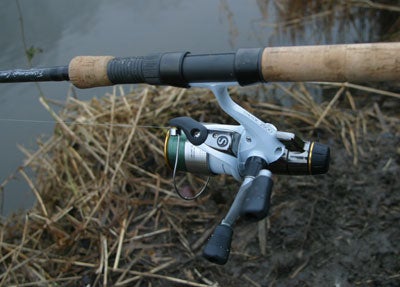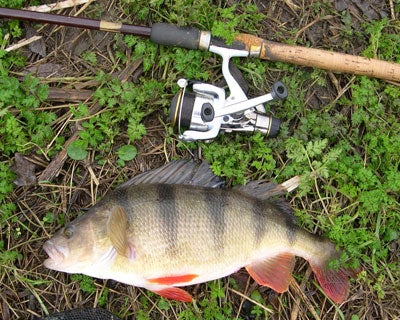| MARK WINTLE |
| Mark Wintle, an angler for thirty-five years, is on a quest to discover and bring to you the magic of fishing. Previously heavily involved with match fishing he now fishes for the sheer fun of it. With an open and enquiring mind, each week Mark will bring to you articles on fishing different rivers, different methods and what makes rivers, and occasionally stillwaters, tick. Add to this a mixed bag of articles on catching big fish, tackle design, angling politics and a few surprises. Are you stuck in a rut fishing the same swim every week? Do you dare to try something different and see a whole new world of angling open up? Yes? Then read Mark Wintle’s regular weekly column. |
| BATTLE OF THE REELS Nearly two years ago, I made a plea for better match reel design . Modern match reels, supposedly suitable for trotting, were simply not up to the job. My main bone of contention was that changes to spool design and overall dimensions had made it difficult to reach the spool with one’s finger, an essential requirement for river float fishing. I thought that we British anglers were simply being palmed off with reels designed for the American spinning market. When I floated this idea in Angling Times as well as on Fishingmagic, those supporting my view far outnumbered those that thought modern reels adequate. There were the usual suggestions that I should use centre-pins or closed-face reels but I am clear in my own mind what I’m looking for. Since then, I’ve noticed that Dave Woodmansey’s AT reviews have taken a different stance. Of course, the limitations of modern reels has been known for at least a decade, and the views of anglers such as John Allerton, Alan Scotthorne, and Roy Marlow, to name but a few, have been suggesting that there had to be a better way. That such knowledge was freely available yet nothing was happening increased my frustration. Quite what event in reel design has triggered a major change is impossible to say but somewhere in the depths of Daiwa and Shimano, there has been a change of thinking. It started with a trickle that, in Shimano at least, has turned into a flood. Even their cheaper reels are getting the re-design that’s making all the difference.
That the world might have changed for the better was the announcement of the new Stradic GTM-RA in a 2500 size about a year ago. Though I had been using some older Stradics in the 1000 size for a year or so, the tiny spool diameter was not quite right. I could see that that re-proportioned spool would do the trick. At the NEC “Go Fishing” show back in February, I had a chance to see this new reel. I was impressed. Graham had got his hands on one at the same time, and when I met him a couple of weeks later, confirmed that this was the reel we were waiting for. There is more than one benefit to changing the size of the spool. Not only is retrieve speed improved, line lay, casting distance, and the fundamental reach to the spool are improved. Build in the Shimano quality, and innovations like ‘Fightin’ Drag’ and excellent bale rollers, and you ought to be looking at a world-beater. I treated myself to a Stradic GTM-RA 2500 back in June. Since the start of the season, I have used it many times, but also continued to use my Mitchell Matches and the older Stradic 1000 reels. This has given me an opportunity to compare the different reels in a variety of conditions. Which reels are best for trotting, playing fish, tangles, and casting? As this is a direct comparison between the new Stradic and the Mitchell Match, I’m going to leave the old Stradics out of the comparison. How did they evolve? The Mitchell Match (the original, not modern incarnations bearing the name) had an extraordinary long gestation period. The original Mitchell 300 appeared in the late forties with a half bail; a few years later, the full bail became available. Garcia Mitchell introduced a version with an automatically opening bail in the early sixties, the “Otomatic”, and in parallel, a high gear version of the 300 had also appeared, most commonly in the form of the “410”. When the two refinements were married in one reel the Match was born in the late sixties. The only real change subsequent to that was the addition of a bail roller to the finger dab bail.
The Shimano has had a long, narrow spool shape for several years. Its bail had had the twist-buster shape for a while too. As I explained earlier, the dramatic change to the overall shape in the last year or so is the one change that has made all the difference. Build Quality Originally, Mitchell reels were made in France. The quality was very good. One or two of the final versions of the original Mitchell Match were made in the Far East (mid eighties?) and there was no doubt that in saving costs the build quality was dropping. The very hard life that Mitchell Matches always endured took its toll though it was more wear and tear than outright failure. If you had them regularly serviced, and replaced worn parts, it was possible to get eight or ten years hard wear out of them. The Stradics were made in Japan until the latest incarnation that are made in Malaysia. Whether the latest versions are as good in quality remains to be seen. I, for one, absolutely hammer reels yet so far cannot see any sign of wear but it’s too early to tell. There have been rumblings about the latest Baitrunners being of a poorer build quality to those older reels that again were made in Japan. Shimano deservedly enjoy a first class reputation, and it would be humbling if that were to slip in the name of cheaper-made reels. There is no doubt that the Shimano reels feel much smoother, with far less play in the mechanism. What I would like to see change on the Shimano reels is for much drabber colours. I’ve been dazzled using this reel in the summer! The Mitchells have it right with the original midnight blue or lighter metallic blue. Trotting I have found both reels excellent for trotting. Line payout is perfect in both cases, with no bedding whatsoever. I always fish with an open bail arm, and the Shimano does give you the option of closing the bail manually. Because the line is wound in the opposite direction to the Mitchell, the way the line is trapped by one’s finger is different, and something that I am still getting used to though I haven’t had any particular problems with this.
It is clear that the problems with finger reach are cured, and therefore I would judge both reels equal in this respect. In both cases it is easier if the spool is in the ‘in’ position rather than its fully extended position but the spool remains reachable in all positions. Casting Excellent line lay in both cases means flawless casting. The Shimano is slower in that you have to manually open the bale arm but fishing with fine lines of 2-4 lbs breaking strain, and with similar sized spools, I would find it hard to separate the two. Speed of use Retrieve speed is similar, so actual fishing time in a time-critical match ought to be the same. The lack of a finger dab on the Shimano (some Shimano models do have trigger bale mechanisms though I haven’t used these) means that there is slightly more fiddling around before casting. It would need a very clever design to incorporate a finger dab with the Shimano, and I’m not going to hold my breath. Daiwa have an old finger dab automatic bale but there is currently no sign of them marrying this with one of their much more modern (and better designed) reels. Perhaps this is food for thought by Daiwa? Playing fish Traditionally, us match anglers play fish by back-winding. We do this because we were using pound bottoms and tiny hooks, but principally because the drag mechanisms available were simply not smooth enough to be relied upon. The Mitchell has the front drag, settable per spool but prone to sticking. I’ve rarely relied on it. Apart from a few special circumstances, one where we fished Mitchell 300s almost like baitrunners for tearaway carp, I’ve done what the majority of Mitchell users have done and screwed up the tension knob, flicked off the anti-reverse, and relied on back winding. Times have changed. Firstly, for much of the time we can use stronger lines and bigger hooks, though not always. But the real difference is that drags such as that built in the Shimano Stradics, with ‘Fightin’ Drag’ actually work. When I fished with Ron Clay and Peter Jacobs at Christmas, I was hooking sizeable carp on 0.08mm bottoms and 22 hooks. The clutch on the Stradic is so finally tuned that it ticked progressively yet the rod was bent double, and the line remained intact, until I really piled on the pressure to get rid of the damn things. Having tested these clutches out on mullet and seatrout, the nearest thing to bonefish I’m going to hook, I can assure you that these clutches are hard to beat. The other significant difference that I can feel is that the roller in the Shimano works whereas the Mitchell one doesn’t, and the net result is the ability to play fish more effectively. Tangles First, I must acknowledge that the complex system of double-jointed levers that constitute the Mitchell Match’s auto bale mechanism has always been prone to attracting tangles. Aside from that, the Mitchell is relatively tangle-free. The built in resistance of the gears prevents accidental back-winding, a common cause of tangles if you let the reel spin freely. The old-fashioned non-skirted spool means that occasionally the line gets behind the chenille-rimmed spool. With the Shimano you’ve got a skirted spool and relatively smooth bale mechanisms so tangles are less likely from those causes. You need to watch for two causes of tangles. Firstly, because I fish with the anti-reverse off, causing the reel to spin by pulling on the line quickly causes a bird’s nest of line if you are not careful. The other annoying tangle maker seems to be when you engage the pickup and begin to wind; occasionally a loose coil of line is thrown and this is quickly wrapped around the line that is meant to be retrieved. This tangle can degenerate into an almighty tangle. I suspect this is down to the way I am using the reel, as I am slowly getting less of this type of tangle, and there are differences in the way that the line is picked up from my finger. Conclusion A new generation of properly proportioned reels has arrived. Further refinement is possible; less garishness, better handles, a touch dab bale and elimination of whatever it is that causes the tangles. The Shimano Stradics may not be perfect but the pros are outweighing the cons, and I can see my Mitchell Matches gradually being retired. I hope that competition from Daiwa and other manufacturers keep Shimano on their toes. We’ve already seen a brave attempt by Cormoran to radically change the proportions of small fixed-spool reels by utilising a much bigger spool though at the expense of tangle-free operation. The battle isn’t over just yet… Next: ‘It Seemed a Good Idea at the Time?’ |
















